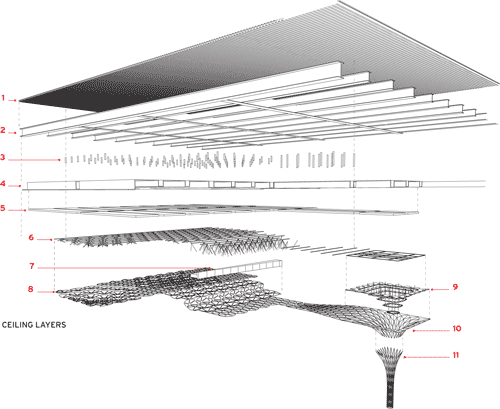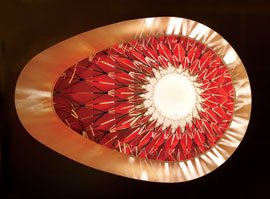When the Whole Is Greater Than the Sum of Its Parts
Multiple lighting, audiovisual, mechanical, and fire-and life-safety systems, among others, had to be considered during the design process. The final three-dimensional model was able to accept information and constraints from many constituencies, including the acoustical and m/e/p engineers, and LED-lighting specialists, creating a series of feedback loops that were reflected and translated directly to fabrication templates for output to the ceiling's installers.
 |
||||
|
An LED lighting system allows the Conga Room's ceiling to change color at the push of a button, and can react to the rhythms of the music on the dance floor (top and left). An exploded axonometric illustrates the ceiling's multilayered assembly (below). Photos: © Benny Chan |
|||

|
||||
Â
But the parametric models did have their limitations. "At some point, there were almost a dozen different consultants working on the project," Atwood says. "Since they couldn't always visualize what we were doing, we had to build a physical model, specifically of the tornado. It reassured them that the design wasn't as complicated as they originally thought when just looking at the drawings."
The ceiling's many layers incorporate a number of elements. House lights and sprinkler heads are conveniently located within the central circle of the ceiling flowers. Tracks hung below the flowers house a multicolored LED lighting system that directs light onto the petals. The designers again used Ecotect to study lighting levels at every petal. In order for the light to be uniformly distributed across the ceiling surface, the tracks had to adjust to the shape of the ceiling. The surface inflection at the back of the space required the lighting system to bend in plan as well as in section to maintain the desired lighting quality.
The architects chose to attach the flowers, which average almost 6 feet in diameter, to metal wires that hang from a Unistrut framing system. Each flower was constructed inside a hexagonal plywood jig that was designed to accommodate the varying petal angles. A metal strap ties each petal to the next. In order for each flower to maintain its shape, the straps had to withstand a certain tolerance of rotation. Predictive modeling of material behavior took into account the elastic deformation of the metal strap and set the limit each flower could rotate in relation to its neighbors.










